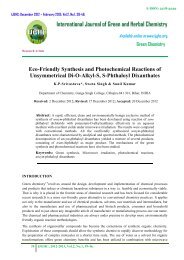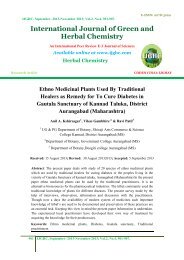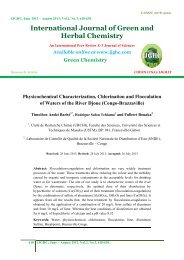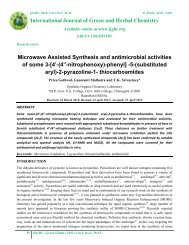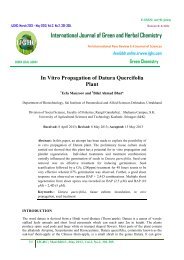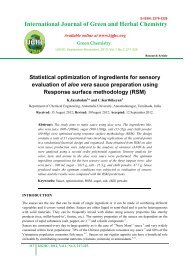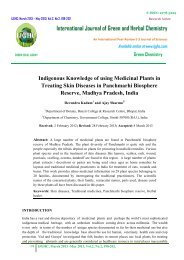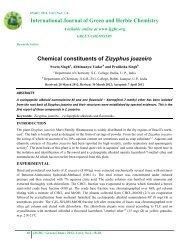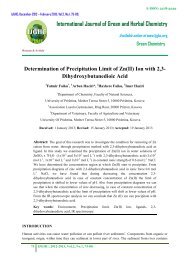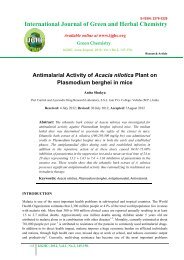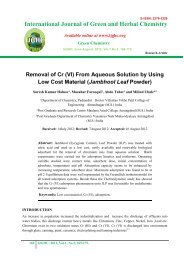International Journal of Green and Herbal Chemistry - IJGHC
International Journal of Green and Herbal Chemistry - IJGHC
International Journal of Green and Herbal Chemistry - IJGHC
Create successful ePaper yourself
Turn your PDF publications into a flip-book with our unique Google optimized e-Paper software.
E-ISSN: 2278-3229<br />
<strong>IJGHC</strong>; March 2013 – May 2013; Vol.2, No.2, 280-284.<br />
Research Article<br />
<strong>International</strong> <strong>Journal</strong> <strong>of</strong> <strong>Green</strong> <strong>and</strong> <strong>Herbal</strong> <strong>Chemistry</strong><br />
An <strong>International</strong> Peer Review E-3 <strong>Journal</strong> <strong>of</strong> Sciences<br />
Available online at www.ijghc.com<br />
CODEN (USA): IJGHAY<br />
<strong>Green</strong> <strong>Chemistry</strong><br />
Estimation <strong>of</strong> the Type <strong>and</strong> Quantity <strong>of</strong> Sugar in Apple<br />
(Malus Domestica)<br />
Ajit V P<strong>and</strong>ya, Ekta Prajapati <strong>and</strong> Ruchi Sinha<br />
Department <strong>of</strong> Biochemistry, C.U.Shah Science College, Ahmedabad, Gujarat, India<br />
Received: 4 April 2013; Revised: 4 May 2013; Accepted: 10 May 2013<br />
Abstract: Carbohydrates are the most abundant class <strong>of</strong> organic compounds found in<br />
living organisms. It is present as a storage form in all the fruits in its various forms <strong>and</strong><br />
quantities. It was determined through a series <strong>of</strong> experiments performed on a selected<br />
sample <strong>of</strong> a small sized Apple (Malus Domestica) as the research fruit <strong>and</strong> the results<br />
revealed that it contained two types <strong>of</strong> sugars: Glucose <strong>and</strong> Fructose, which are<br />
classified under the class <strong>of</strong> Monosaccharides. The quantity <strong>of</strong> sugar was estimated to<br />
the value <strong>of</strong> 2.23 gm in 123.5gm <strong>of</strong> apple. The values obtained were found to be below<br />
the recommended daily intake. A large red apple contains 34g <strong>of</strong> total carbohydrates,<br />
including 25g <strong>of</strong> sugar, 6g <strong>of</strong> dietary fiber <strong>and</strong> 3g complex carbohydrates. Under certain<br />
conditions, the sugar content <strong>of</strong> the fruit may vary such as temperature, time on which<br />
the experiment was performed on it, degree <strong>of</strong> ripeness <strong>of</strong> the fruit, level <strong>of</strong> oxidation the<br />
fruit has undergone, season <strong>of</strong> the fruit harvesting <strong>and</strong> the methods used during<br />
cultivation. Thus it is recommended to consume fruits regularly <strong>and</strong> in large quantities in<br />
order to fulfill the nutritional requirements <strong>of</strong> the body.<br />
Keywords: Carbohydrates, Apple, Glucose, Fructose, Folin-Wu method, Homogenate.<br />
INTRODUCTION<br />
Carbohydrates are the molecules, which consist <strong>of</strong> carbon, hydrogen <strong>and</strong> oxygen atoms. They are<br />
major food source <strong>and</strong> a key form <strong>of</strong> energy for most organisms. When combined together to form<br />
polymers, carbohydrates can function as long term food storage molecules, as protective membranes<br />
for organisms <strong>and</strong> cells, <strong>and</strong> as the main structural support for plants <strong>and</strong> constituents <strong>of</strong> many cells<br />
280 <strong>IJGHC</strong>; March2013 -May 2013, Vol.2, No.2, 280-284.
Estimation ….<br />
Ajit V P<strong>and</strong>ya et al.<br />
<strong>and</strong> their contents. Besides these, various important physiological functions are linked with the<br />
carbohydrates. The carbohydrates (saccharides) are divided into four chemical groupings:<br />
monosaccharides, disaccharides, oligosaccharides, <strong>and</strong> polysaccharides. In general, the<br />
monosaccharides <strong>and</strong> disaccharides, which are smaller (lower molecular weight) carbohydrates, are<br />
commonly referred to as sugars 1 . Monosaccharide - this is the smallest possible sugar unit. Examples<br />
include glucose, galactose or fructose. In human nutrition, galactose can be found most readily in milk<br />
<strong>and</strong> dairy products, while fructose is found mostly in vegetables <strong>and</strong> fruit. Disaccharide - two<br />
monosaccharide molecules bonded together. Disaccharides are polysaccharides - "poly..." specifies<br />
any number higher than one, while "di..." specifies exactly two. Examples <strong>of</strong> disaccharides include<br />
lactose, maltose, <strong>and</strong> sucrose. If you bond one glucose molecule with a fructose molecule you get a<br />
sucrose molecule. Sucrose is found in table sugar, <strong>and</strong> is <strong>of</strong>ten formed as a result <strong>of</strong> photosynthesis<br />
(sunlight absorbed by chlorophyll reacting with other compounds in plants). If you bond one glucose<br />
molecule with a galactose molecule you get lactose, which is commonly found in milk.<br />
Polysaccharide - a chain <strong>of</strong> two or more monosaccharides. The chain may be branched or unbranched.<br />
Polysaccharide molecule chains may be made up <strong>of</strong> hundreds or thous<strong>and</strong>s <strong>of</strong> monosaccharides.<br />
Polysaccharides are polymers. A simple compound is a monomer, while a complex compound is a<br />
polymer which is made <strong>of</strong> two or more monomers. Carbohydrates perform numerous roles in living<br />
organisms. Polysaccharides serve for the storage <strong>of</strong> energy (e.g., starch <strong>and</strong> glycogen), <strong>and</strong> as<br />
structural components (e.g., cellulose in plants <strong>and</strong> chitin in arthropods). The 5-carbon<br />
monosaccharide ribose is an important component <strong>of</strong> coenzymes (e.g., ATP, FAD, <strong>and</strong> NAD) <strong>and</strong> the<br />
backbone <strong>of</strong> the genetic molecule known as RNA.<br />
The related deoxyribose is a component <strong>of</strong> DNA. Saccharides <strong>and</strong> their derivatives include many<br />
other important biomolecules that play key roles in the immune system, fertilization, preventing<br />
pathogenesis, blood clotting, <strong>and</strong> development 2 . The brain <strong>and</strong> neurons generally cannot burn fat for<br />
energy, but use glucose or ketones. Humans can synthesize some glucose (in a set <strong>of</strong> processes known<br />
as gluconeogenesis) from specific amino acids, from the glycerol backbone in triglycerides <strong>and</strong> in<br />
some cases from fatty acids. Carbohydrate <strong>and</strong> protein contain 4 calories per gram, while fats contain<br />
9 calories per gram. In the case <strong>of</strong> protein, this is somewhat misleading as only some amino acids are<br />
usable for fuel. Polysaccharides are also common sources <strong>of</strong> energy. Many organisms can easily break<br />
down starches into glucose, however, most organisms cannot metabolize cellulose or other<br />
polysaccharides like chitin <strong>and</strong> arabinoxylans. These carbohydrates types can be metabolized by some<br />
bacteria <strong>and</strong> protists. Ruminants <strong>and</strong> termites, for example, use microorganisms to process cellulose.<br />
Even though these complex carbohydrates are not very digestible, they represent an important dietary<br />
element for humans, called dietary fiber. Fiber enhances digestion, among other benefits 3 .Foods high<br />
in carbohydrate include fruits, sweets, s<strong>of</strong>t drinks, breads, pastas, beans, potatoes, bran, rice, <strong>and</strong><br />
cereals. Carbohydrates are a common source <strong>of</strong> energy in living organisms; however, no carbohydrate<br />
is an essential nutrient in humans 4 . Apple features oval or pear shape; <strong>and</strong> the outer skin has different<br />
colors depending upon the cultivar type. Its seeds are inedible because <strong>of</strong> their bitter taste. Fresh<br />
apples can be kept at room temperature for few days <strong>and</strong> stored inside the refrigerator for two to three<br />
weeks. It should be washed in clean running cold water before use to remove any surface dust <strong>and</strong><br />
pesticide/fungicide residues. According to the environmental-working group reports, apple is one <strong>of</strong><br />
the heavily pesticide-contaminated produce. The most common pesticides found on apple are organophosphorous<br />
<strong>and</strong> organo-chloride pesticides like Permethrin <strong>and</strong> DDT. Therefore, it is recommended<br />
to wash the fruit thoroughly before use.<br />
The main objectives <strong>of</strong> this research work are to determine the type <strong>of</strong> carbohydrate present in the<br />
sample fruit (Apple (Malus Domestica)) <strong>and</strong> to quantify the amount <strong>of</strong> sugar present in it. Apple is<br />
one <strong>of</strong> the most popular fruits, favorite <strong>of</strong> health conscious, fitness lovers who believe in the concept<br />
281 <strong>IJGHC</strong>; March2013 -May 2013, Vol.2, No.2, 280-284.
Estimation ….<br />
Ajit V P<strong>and</strong>ya et al.<br />
“health is wealth.” This fruit is packed with rich phyto-nutrients that in the true senses indispensable<br />
for optimal health. The antioxidants in apple have much health promoting <strong>and</strong> disease prevention<br />
properties; thus truly justifying the statement, “an apple a day keeps the doctor away.” Apples are<br />
obtained from the medium-sized tree belonging to the Rosaceae family. The apple tree is originated in<br />
the mineral-rich mountain ranges <strong>of</strong> Kazakhstan, <strong>and</strong> now being cultivated in many parts <strong>of</strong> the world.<br />
The best variety <strong>of</strong> apples is found in the end <strong>of</strong> July or the beginning <strong>of</strong> October.<br />
MATERIALS AND METHODS<br />
Sample Collection: The Apple for the research work was bought from Vadsar market <strong>and</strong> stored at<br />
room temperature. The experiment was performed on 3 rd <strong>of</strong> September 2012. All reagents <strong>and</strong><br />
st<strong>and</strong>ards used in this work for various determinations were <strong>of</strong> laboratory grade. The methods used in<br />
this work are the st<strong>and</strong>ard methods.<br />
Preparation <strong>of</strong> Homogenate: A half ripe apple was selected for the experiment. The weight was<br />
found out to be 123.5 gm, out <strong>of</strong> which 20.3 gm was taken for the experiment. In order to perform the<br />
further experiments the sample should be in a liquid state hence the apple was crushed in a mortar <strong>and</strong><br />
pestle <strong>and</strong> made into a fine paste. 100ml distilled water was added in order to reduce the<br />
concentration. This purified preparation is the “Homogenate” for the sample. The quantity <strong>of</strong><br />
homogenate was measured <strong>and</strong> was found out to be 104ml. Two types <strong>of</strong> tests were performed on on<br />
the homogenate in order to determine the type <strong>and</strong> the quantity <strong>of</strong> the sugar present in apple<br />
differently.<br />
Estimation <strong>of</strong> type <strong>of</strong> Carbohydrate: To find out the types <strong>of</strong> carbohydrate present in any<br />
sample a series <strong>of</strong> tests are performed on it.<br />
These include:<br />
TEST OBSERVATION INFERENCE<br />
Test for carbohydrate:<br />
Molisch’s Test Purple ring obtained Therefore, Carbohydrate is present<br />
Test for polysaccharide:<br />
Iodine Test No purple colour obtained Therefore, Polysaccharide is absent<br />
Test for Reducing Sugar:<br />
Benedict’s Test<br />
Fehling’s Test<br />
Picric acid Test<br />
Test for Ketose Sugar:<br />
Seliwan<strong>of</strong>f’s Test<br />
Phosphoric acid Test<br />
Cobaltous chloride Test<br />
Test for Monosaccharide:<br />
Barfoed’s Test<br />
Red-green ppt obtained<br />
Red ppt obtained<br />
Reddish brown colour obtained<br />
Cherry red colour obtained<br />
Brown coloured ring obtained<br />
Purple coloured ring obtained<br />
Red button obtained in the bottom<br />
<strong>of</strong> the test tube<br />
Therefore, Reducing sugars such as<br />
Glucose, Fructose, Galactose,<br />
Maltose or Lactose may be present.<br />
Therefore, ketose sugar such as<br />
Fructose or Sucrose may be<br />
present.<br />
Monosaccharide such as Glucose,<br />
Fructose or Galactose may be<br />
present.<br />
Test for Osazone:<br />
Phenyl Hydrazine Test Broom shaped osazone obtained. Glucose is confirmed.<br />
Result: From the above tests it was confirmed that Glucose <strong>and</strong> Fructose are present in Apple It should be noted<br />
that.Starch is a polysaccharide but it was not found out from these tests as it is present in the peel <strong>of</strong> the apple<br />
<strong>and</strong> the homogenate was devoid <strong>of</strong> it.<br />
282 <strong>IJGHC</strong>; March2013 -May 2013, Vol.2, No.2, 280-284.
Estimation ….<br />
Ajit V P<strong>and</strong>ya et al.<br />
Estimation <strong>of</strong> Glucose by Folin-Wu method: Principle: The sample is heated with alkaline copper<br />
solution by using a special type <strong>of</strong> Folin-Wu tubes. Glucose (<strong>and</strong> other reducing substances) reduces<br />
copper from the cupric ions to the cuprous ions. When phosphomolybdic acid is added it is reduced<br />
from cuprous form to blue coloured molybdenum blue. Intensity <strong>of</strong> molybdenum blue is directly<br />
proportional to glucose. Its concentration is measured colourimetrically with a known st<strong>and</strong>ard at 420<br />
nm.<br />
Result: The sample <strong>of</strong> apple contains 2.23gm glucose.<br />
RESULT AND DISCUSSION<br />
The type <strong>and</strong> quantity <strong>of</strong> sugar was estimated from Apple (Malus Domestica). The results revealed<br />
that Glucose <strong>and</strong> Fructose are present in the apple <strong>and</strong> the sugar content in it is 2.23 gm. Variations<br />
may occur in the quantity <strong>of</strong> Sugar because <strong>of</strong> the time interval between the experiments performed.<br />
Oxidation caused during the preparation <strong>of</strong> homogenate also destroys some sugar. Dilution <strong>of</strong> the<br />
sample also leads to the deterioration <strong>of</strong> the quantity <strong>of</strong> sugar.<br />
CONCLUSION<br />
It is thus concluded from the above experiments that Glucose <strong>and</strong> Fructose are present in the apple<br />
<strong>and</strong> the sugar content in it is 2.23 gm. The destruction <strong>of</strong> sugar occurs on long exposure <strong>of</strong> the fruit<br />
after being cut.<br />
RECOMMENDATION<br />
It is suggested that fruits used should be fresh obtain maximum nutrients from it <strong>and</strong> fresh fruits<br />
should be consumed regularly in order to maintain proper health. Further research should be<br />
performed in order to check whether time is a main factor for the proper quantity for sugar.<br />
ACKNOWLEDGEMENT<br />
We are thankful to research students, all the staff members, the head <strong>of</strong> department <strong>and</strong> Principal<br />
Mam <strong>of</strong> C.U Shah Science College for allowing us to perform this research work in the laboratory.<br />
REFERENCES<br />
1. L.Flitsch, Sabine,V. Ulijn, Rein, "Sugars tied to the spot". Nature,2003, 421 (6920): 219–20.<br />
doi:10.1038/421219a. PMID 12529622.<br />
2. John Merle Coulter, Charler Reid Barnes, Henry Ch<strong>and</strong>ler Cowles (1930), A Textbook <strong>of</strong> Botany for<br />
Colleges <strong>and</strong> Universities1930.<br />
3. L.Pichon,J.F.Huneau, G. Fromentin, D.Tomé, "A high-protein, high-fat, carbohydrate-free diet reduces<br />
energy intake, hepatic lipogenesis, <strong>and</strong> adiposity in rats". The <strong>Journal</strong> <strong>of</strong> nutrition,2006. 136 (5):<br />
1256–60. PMID 16614413.<br />
4. E.C.Westman,. "Is dietary carbohydrate essential for human nutrition". The American journal <strong>of</strong> clinical<br />
nutrition,2000, 75 (5):951–3; author reply 953–4. PMID 11976176<br />
*Corresponding Author; Dr. Ajit V P<strong>and</strong>ya<br />
Department <strong>of</strong> Biochemistry, C.U.Shah Science College, Ahmedabad, Gujarat, India<br />
283 <strong>IJGHC</strong>; March2013 -May 2013, Vol.2, No.2, 280-284.



